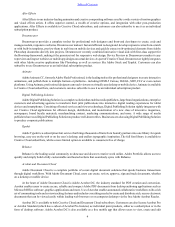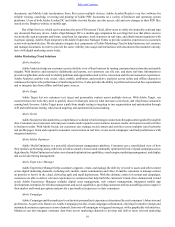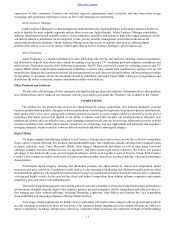Adobe 2015 Annual Report Download - page 18
Download and view the complete annual report
Please find page 18 of the 2015 Adobe annual report below. You can navigate through the pages in the report by either clicking on the pages listed below, or by using the keyword search tool below to find specific information within the annual report.
Table of Contents
18
Name Age Positions
Richard T. Rowley 59 Vice President, Corporate Controller and Chief Accounting Officer
Mr. Rowley joined Adobe in November 2006 and currently serves as Vice President, Corporate
Controller and Principal Accounting Officer. Prior to joining Adobe, Mr. Rowley served as Vice
President, Corporate Controller, Treasurer and Principal Accounting Officer at Synopsys, Inc., a
semiconductor design software company, from December 2002 to September 2005 and from
1999 to December 2002, Mr. Rowley served as Vice President, Corporate Controller and Principal
Accounting Officer. From 1994 to 1999, Mr. Rowley served in several finance-related positions
at Synopsys. Mr. Rowley is a certified public accountant.
ITEM 1A. RISK FACTORS
As previously discussed, our actual results could differ materially from our forward-looking statements. Factors that might
cause or contribute to such differences include, but are not limited to, those discussed below. These and many other factors described
in this report could adversely affect our operations, performance and financial condition.
If we cannot continue to develop, market and offer new products and services or enhancements to existing products and services
that meet customer requirements, our operating results could suffer.
The process of developing new high technology products and services and enhancing existing products and services is
complex, costly and uncertain. If we fail to anticipate customers’ changing needs and emerging technological trends, our market
share and results of operations could suffer. We must make long-term investments, develop or obtain appropriate intellectual
property and commit significant resources before knowing whether our predictions will accurately reflect customer demand for
our products and services. If we are unable to extend our core technologies into new applications and new platforms and to anticipate
or respond to technological changes, the market’s acceptance of our products and services could decline and our results would
suffer. Additionally, any delay in the development, production, marketing or offering of a new product or service or enhancement
to an existing product or service could result in customer attrition or impede our ability to attract new customers, causing a decline
in our revenue, earnings or stock price and weakening our competitive position. We maintain strategic relationships with third
parties to market certain of our products and services and support certain product functionality. If we are unsuccessful in establishing
or maintaining our relationships with these third parties, our ability to compete in the marketplace, to reach new customers and
geographies or to grow our revenue could be impaired and our operating results could suffer.
We offer our products on a variety of personal computers, tablet and mobile devices. Recent trends have shown a technological
shift from personal computers to tablet and mobile devices. If we cannot continue to adapt our products to tablet and mobile
devices, our business could be harmed. To the extent that consumer purchases of these devices slow down, or to the extent that
significant demand arises for our products or competitive products on other platforms before we offer our products on those
platforms, our business could be harmed. Releases of new devices or operating systems may make it more difficult for our products
to perform or may require significant costs in order for us to adapt our solutions to such devices or operating systems. These
potential costs and delays could harm our business.
Introduction of new products, services and business models by competitors or others could harm our competitive position and
results of operations.
The markets for our products and services are characterized by intense competition, evolving industry standards, emerging
business and distribution models, disruptive technology developments, short product and service life cycles, price sensitivity on
the part of customers and frequent new product introductions (including alternatives with limited functionality available at lower
costs or free of charge). Any of these factors could create downward pressure on pricing and gross margins and could adversely
affect our renewal and upgrade rates, as well as our ability to attract new customers. Our future success will depend on our ability
to enhance our existing products and services, introduce new products and services on a timely and cost-effective basis, meet
changing customer needs, extend our core technology into new applications, and anticipate and respond to emerging standards,
business models, software delivery methods and other technological developments, such as the evolution and emergence of digital
application marketplaces as a direct sales and software delivery environment. These digital application marketplaces often have
exclusive distribution for certain platforms, which may make it more difficult for us to compete in these markets. If any competing
products, services or operating systems (that do not support our solutions) achieve widespread acceptance, our operating results
could suffer. In addition, consolidation has occurred among some of the competitors in the markets in which we compete. Further
consolidations in these markets may subject us to increased competitive pressures and may therefore harm our results of operations.
The introduction of certain technologies may reduce the effectiveness of our products. For example, some of our products
rely on third-party cookies, which are placed on individual browsers when consumers visit websites that contain advertisements.
We use these cookies to help our customers more effectively advertise, to gauge the performance of their advertisements, and to
detect and prevent fraudulent activity. Consumers can block or delete cookies through their browsers or “ad-blocking” software
























